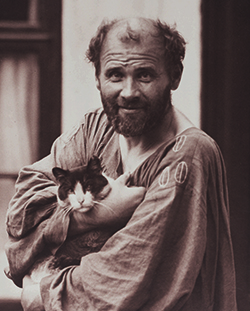| 1862 | Gustav Klimt was born in Baumgarten, then a suburb of Vienna, to a Goldsmith household. |
| 1876 | Klimt entered the Kunstgewerbeschule (School of Arts and Crafts) in Vienna, where he would spend seven years, studying drawing and decorative painting. His brother Ernst Klimt (18864-92) also studied at the same college. |
| 1880 | Gustav and Ernst received their first large-scale commission of four allegorical paintings for the ceiling in the home of the Viennese architect Johann Sturany. |
| 1883 | The Klimt brothers and Franz Matsch (1861-1942) formed the Künstlerkompanie (Artists’ Company), a studio community that carried out decorative commissions. Its important commissions included the ceiling paintings in the two staircases of the new Burgtheater (1886-8), and the spandrel paintings on the staircase of the Kunsthistorisches Museum (1890-1). |
| 1886 | Richard von Krafft-Ebing published Psychopathia Sexualis: eine Klinisch-Forensische Studie (Sexual Psychopathy: A Clinical-Forensic Study). It popularized the terms sadism and masochism. |
| 1888 | On completing the Burgtheater murals, Klimt was awarded the highest imperial honour, the Golden Order of Merit (with Crown). |
| 1891 | Klimt joined the Künstlerhaus, the conservative Viennese professional association representing Austrian artists. |
| 1894 | Klimt received the Faculty Painting commission from the University of Vienna. This work, now destroyed, showed Klimt’s increasing diverting away from the established art tradition. This daring project caused great scandal among the art and political world of Vienna. |
| 1895 | Sigmund Freud and Josef Breuer published Studien über Hysterie (Studies on Hysteria). The book introduced the technique of psychoanalysis as a means of cure, but it was not recognized as legitimate until years later. |
| 1897 | Vereinigung bildender Künstler Österreichs (Union of Austrian Artists), known as the ‘Secession,’ was founded. Klimt was elected its first president. The society looked for alternatives to the dominant academic aesthetic, and hoped to forge closer connections with international artistic development. It held its first exhibition the next year. |
| 1900 | Sigmund Freud published Die Traumdeutung (The Interpretation of Dreams). It puts forward the theory of the unconscious in relation to dream interpretation, and discusses for the first time the would-be Oedipus complex theory |
| 1902 | Klimt presented Beethovenfries in Secessionists’ 14th exhibition. The significance and innovation of this exhibition lies in its successful synthesis of monumentality and ornamentation. |
| 1903 | Josef Hoffman, Koloman Moser, and Fritz Waerndorfer founded Wiener Werkstätte (Viennese Workshop). It was inspired by the concept of the Gesamtkunstwerk (‘total artwork’) and aimed to reevaluate the role of the applied arts. These ideals also constituted an essential part of Klimt’s artistic concerns and he remained in close contact with the company. |
| 1905 | Klimt and his supporters resigned from the Viennese Secession. |
| 1907 | Klimt met Egon Schiele for the first time. The two developed a close relationship. |
| 1908 | Klimt and his supporters organized the first Kunstschau Wien (Viennese Art Show), which contained only Austrian artists’ works, and stressed the idea of the equal standing between the so-called high art and applied arts. |
| 1909 | The second Kunstschau was held, this time it included art from outside Vienna and Austria. Schiele, among other young artists, made his debut in it. Klimt claimed that the young artists did not understand him and that they had gone in a different direction. |
| 1910-4 | Klimt’s reputation grew increasingly abroad, in countries such as Germany, Czech, and above all Italy. |
| 1914 | The First World War broke out. For the following four years during the war, artistic life in Vienna was virtually paralyzed. |
| 1918 | Klimt suffered a stroke and died from pneumonia on 6 February. Schiele made a last drawing of him in the mortuary. |

Gustav Klimt with Cat, 1912








